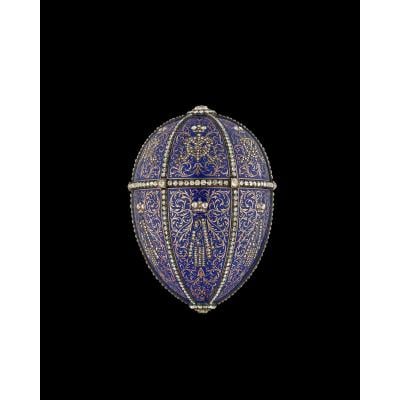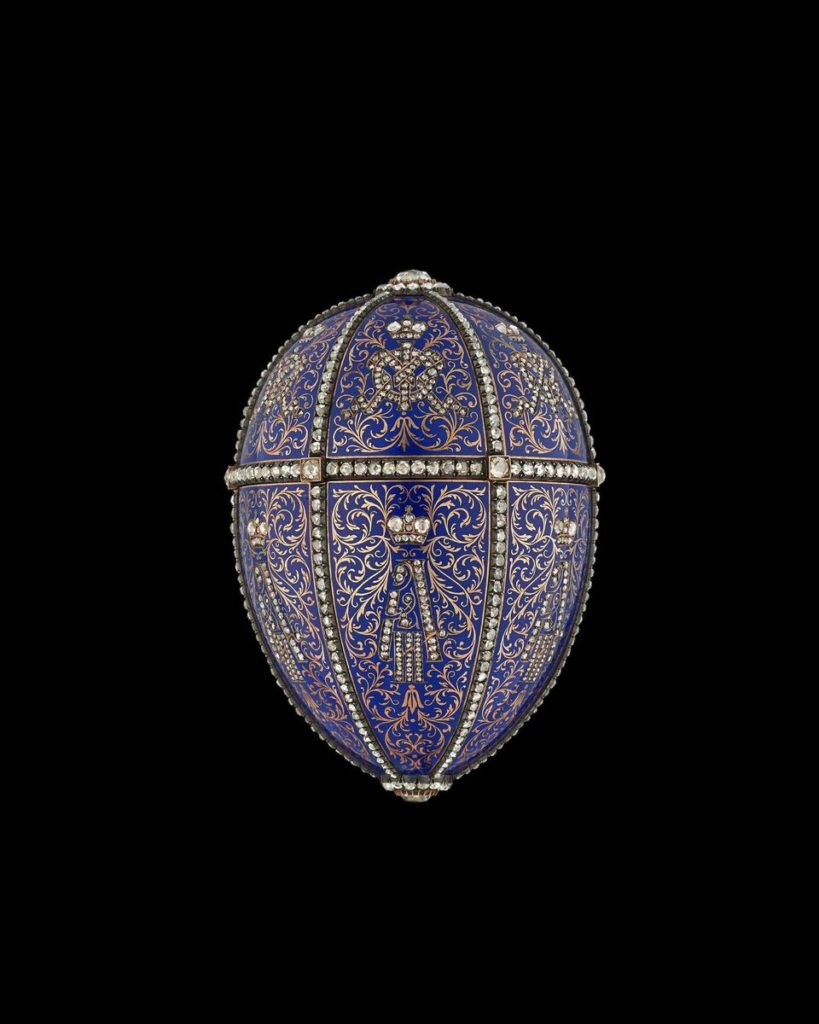
Posted in: Exhibitions
 Twelve Monogram Egg by Faberge, 1896. Photo courtesy Hillwood Estate, Museum & Gardens.
Faberge Twelve Monogram Egg, 1896. Photo by Alex Braun. Used with permission from Hillwood Estate, Museum & Gardens.
This Faberge masterpiece, the Twelve Monogram Egg, is part of a special exhibition at the Hillwood Estate, Museum, and Gardens. Faberge Rediscovered aims to reestablish Peter Carl Faberge as the premiere Russian decorative artist of his time.
Twelve Monogram Egg by Faberge, 1896. Photo courtesy Hillwood Estate, Museum & Gardens.
Faberge Twelve Monogram Egg, 1896. Photo by Alex Braun. Used with permission from Hillwood Estate, Museum & Gardens.
This Faberge masterpiece, the Twelve Monogram Egg, is part of a special exhibition at the Hillwood Estate, Museum, and Gardens. Faberge Rediscovered aims to reestablish Peter Carl Faberge as the premiere Russian decorative artist of his time.
The Twelve Monogram Egg
Perhaps the most exciting contribution this exhibition makes in jewelry history is the re-dating of three Faberge eggs. This one, once believed to have been fashioned in 1892, now holds court as the 1896 Easter egg. Presented to Maria Feodorovna that Easter, the egg serves as a memorial to the marriage and reign of Maria and Alexander III. Framed and set in red gold, the Twelve Monogram Egg consists of 6 panels made from translucent blue enamel. The central opening divides each panel into two halves. On the top half, each panel bears the Imperial Crown made of diamonds and the monogram of Maria Feodorovna made from rose-cut diamonds. On the bottom half, each panel bears the Imperial Crown and the monogram of Alexander III, also in rose-cut diamonds. Each panel features a band of rose-cut diamonds. At the two crowning points of the egg, top and bottom, rest a portrait diamond surrounded by smaller diamonds.Surprise Rediscovered
Inside, satin lines the egg to provide cushion for the surprise which was lost until just a few years ago. When Maria Feodorovna opened the egg in Easter 1896, only several months following her husband's death, she found a grand surprise. A folding screen with six framed portraits of her husband and ten sapphires. Each portrait showed Alexander III wearing a different uniform. {source} Upon discovering what they felt was the Twelve Monogram surprise, historians put the jewel to the test. It passed without doubt. First, the red gold framing the surprise matches the red gold decorating the egg. Also, the deep blue of the sapphires matches perfectly the deep blue enamel of the egg itself. Next, the curators at Hillwood inserted the surprise into the Twelve Monogram Egg. It fit perfectly, as a hand to a glove. In addition, its dimensions and maker's marks match the notations written about it on the original Faberge invoice. Finally, descriptions in various auction catalogs demonstrated the appropriate provenance for the surprise.Passed Down Through Time
In 1961, Prince Dimitri offered the surprise for sale through Christie's London. Prince Dimitri was the son of Grand Duchess Xenia Alexandrovna, the eldest daughter of Maria Feodorovna and Alexander III. Before passing down through time, the egg belonged to the Empress Maria Feodorovna. She received it from her son, Tsar Nicholas II, of the Romanov Empire in Russia, on Easter of 1896. Until her exile, the empress kept the egg in Anichkov Palace, the Imperial Palace in St. Petersburg. That year marked the first year the Romanovs commissioned Faberge to make two annual Easter eggs. One for the Empress and one for Nicholas II's wife, Alexandra Feodorovna. Alexandra Feodorovna was better known by her family as Princess Alicky. Born Princess Alix of Hesse and by Rhine, she was the granddaughter of Queen Victoria of the British Empire.A Treacherous End
The Romanovs met a treacherous end, having been executed in their own home during the overthrow of Russia by the Provincial Government. Kept under house arrest, many previous attempts made by revolutionaries to storm the castle and murder the Tsar and his family were thwarted by the soldiers guarding the Royal family. Alas, eventually the guards chose sides with the Duma, the legislative body of the new Provincial Government. These soldiers, under the guise of ushering the family to safety in the basement, ambushed them at their most vulnerable moment. Every member of the family died of bullet wounds, beginning with Tsar Nicholas II, who held his infant son as he fell dying to the ground. Those treasures not secreted away by Maria Feodorovna and her allies wound up in the Kremlin Armory in Moscow, where they remained until the early 1930s. Thereafter, officials in Stalin's regime began selling items from the treasury to raise funds for the government. Hillwood officials estimate that a Paris-based jeweler purchased the Twelve Monogram Egg from Russian officials. Next, a Mrs. G. V. Berchielli purchased the egg and kept it with her in Italy.The Egg at Hillwood
Finally, Marjorie Merriweather Post, going by her married name of Mrs. Joseph E. Davies (1935-1955), purchased the Faberge egg from Mrs. Berchielli. Marjorie Post kept the egg at her home until her death. Today, it remains part of the permanent collection at Hillwood Estate, Museum and Gardens. As I mentioned before, visitors have a special opportunity to view this gorgeous Faberge egg enveloped in the history of the artistry of Faberge at Hillwood's Faberge Rediscovered exhibition. The exhibition remains on view until January 2019. For more information, please visit Hillwood's website.6 years ago
21 view(s) 